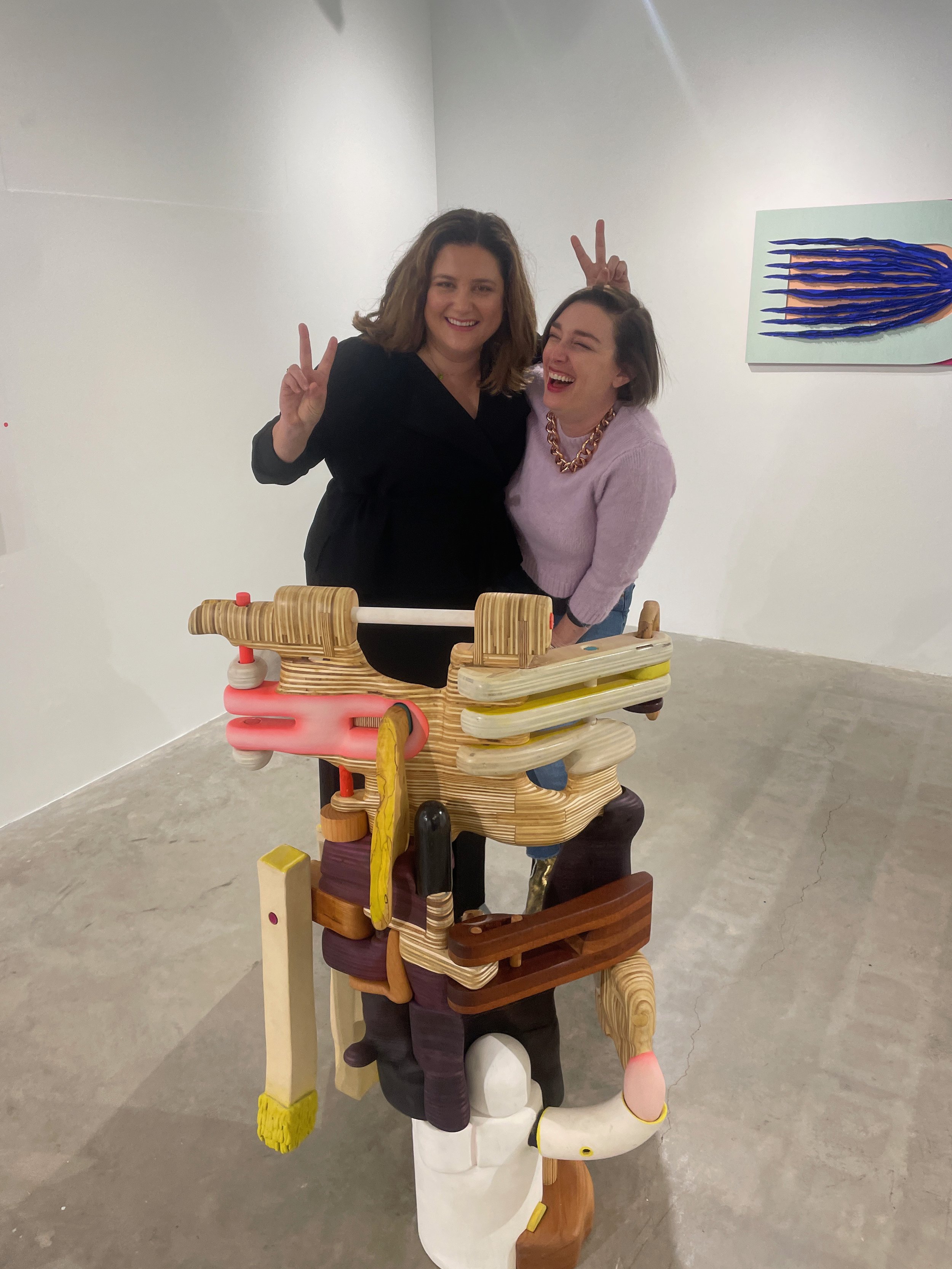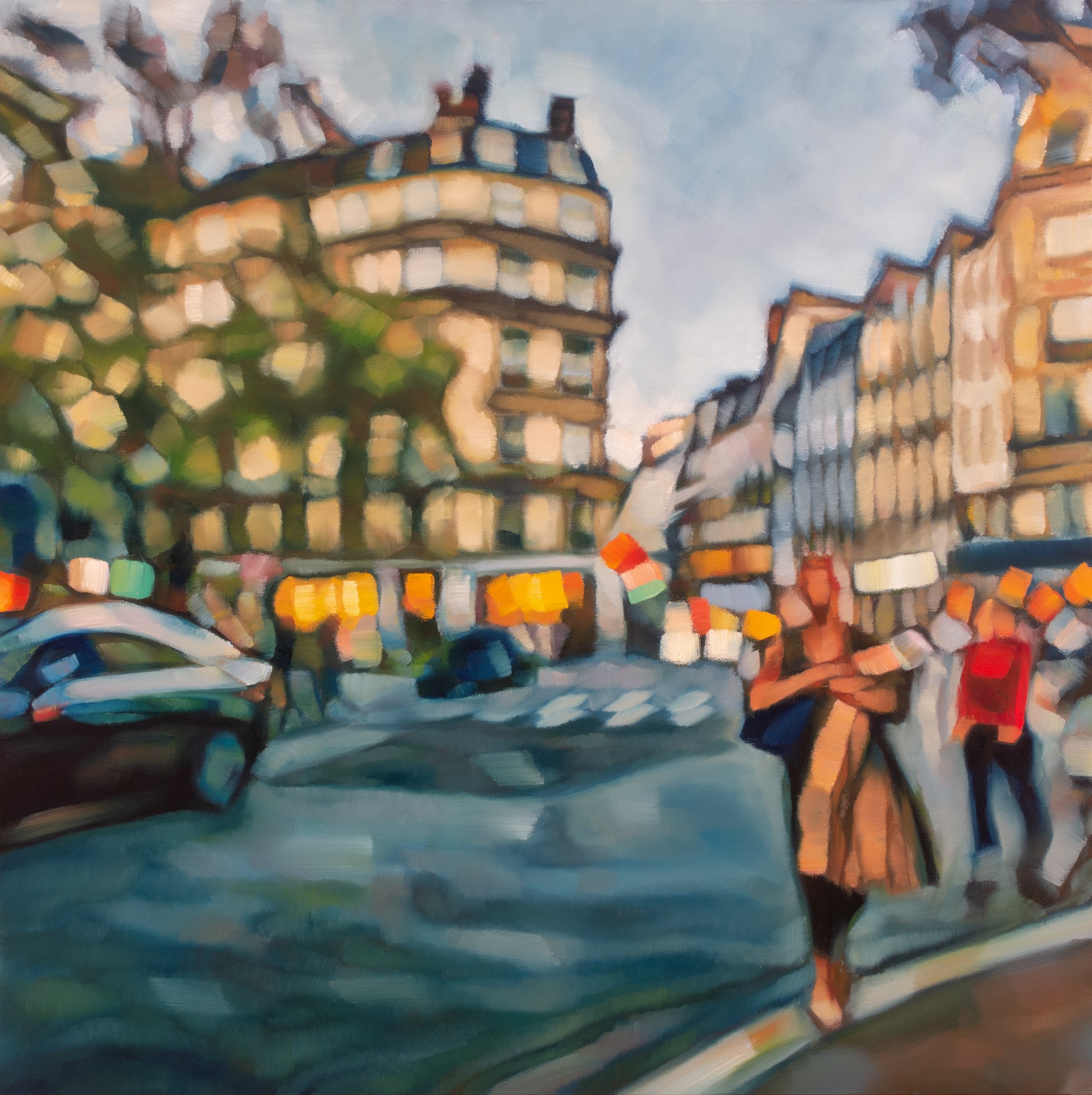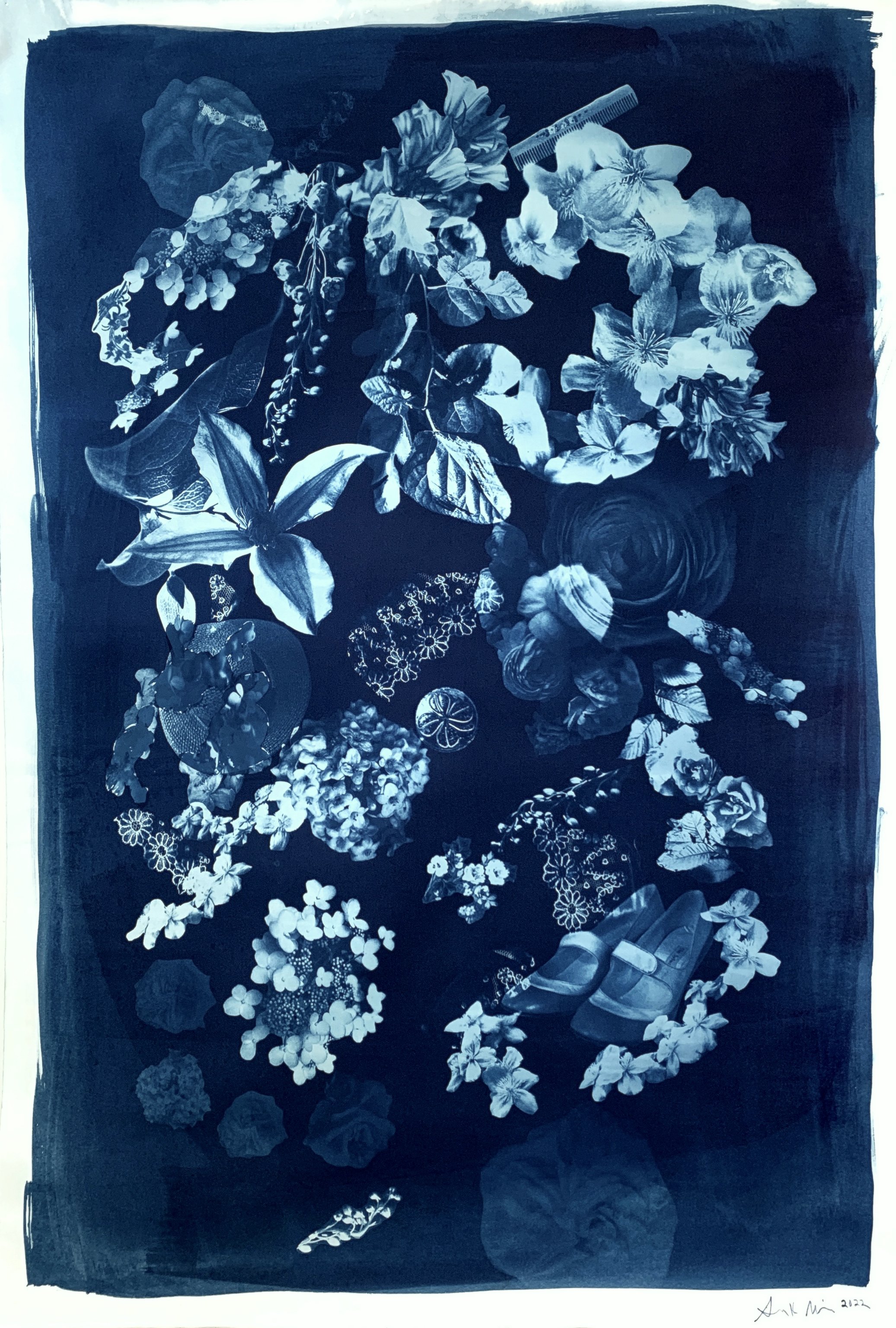Kaylee Hennessey: We’re thrilled to be joined today by Mallory Ruymann and Leah Triplett Harrington, two Boston based curators who recently teamed up to curate “A Romance Of…” at Abigail Ogilvy Gallery. We wanted to get to know you better as curators, and I just want to lead off by saying that you have both been a dream to work with, we've had so much fun during this show, and thank you!
So first off, we'd love to hear how you two met and how you decided to work together.
Mallory Ruymann: Kaylee, thank you so much for that wonderful introduction. And thank you so much to you, Mariana, and Abigail for being incredible partners on this exhibition. We couldn't think of a better team to work with.
Speaking of relationships, Leah, how did we meet again?
Leah Triplett Harrington: I totally agree! It's been such a wonderful opportunity to get to work with the whole team at AOG, and it's been really fun to work with an all women team - aside from our male identifying installer, the entire exhibition team has been woman-identifying.
Mallory and I met at a gathering called the Society of Contemporary Art Historians - the Boston Chapter - almost 10 years ago now, and really enjoyed each other's company and conversation from the get-go. We’ve been friends since.
Mallory: Navigating the relationships the come with working in the contemporary art space can be challenging. When you find people that are cheerleaders for you, that lift you up, support you, and mentor you, it’s incredibly special. Leah was leading several writing projects, including Big, Red & Shiny, as well as a project called The Rib. She had asked me to write a few reviews for her, and that's when we first started collaborating professionally.
For both of our practices, it is so helpful whenever you're publishing something or putting something out into the world to have additional eyes on it, and being able to reach out to ask: “Does this sound the way I want it to sound?” Leah has always been that person for me, and I trust her to see the parts of my work that are incomplete. We started traveling for research and going to art fairs together, too, but during the pandemic that all stopped. Our dear friend Matt Murphy started hosting something called Painters Conference on Zoom. We both were fascinated by this behind-the-scenes glimpse into the practices of some of the most exciting painters working in the United States today, and it made us think about how we would talk about our curatorial, research, and writing practices. From there, we came up with a few show ideas together, and presented one to Matt’s group.
Leah: All of these shows have then explored our perception and thinking about the femme body and what it's like to be a femme - identifying person in the 21st century: how we contend with the body, the screen, and how we navigate craft or tradition to construct these dialogues. Mallory has been a wonderful partner on many, many projects, always eager to jump into anything that I crazily say yes to. We also come at things with a very complementary skill set and perspective, bringing our different professional experiences together.
Our curatorial vision is distinct, but parallel. I think we're both interested in artists who are contending with some of the issues, topics or themes that we're thinking about. In A Romance Of… for example, Mallory suggested installing Elspeth’s work, which is very much dealing with architecture, windows, and portals, in conversation with the gallery’s windows, a spatially thoughtful decision. I just love how we can bring our own perspectives into one cohesive vision.
Kaylee: I have just been so in awe working with both of you, and how this amazing friendship has translated into something so professionally wonderful. I would also like to acknowledge that this exhibition was a passion project, and that you both have full time jobs outside of this curatorial collaboration. Can you each describe what you do day to day?
Mallory: Essentially, I'm a curator and art advisor in my day job. I'm the managing partner of art_works, where we build significant collections of contemporary art. We work with private clients to shape their collections through the lens of specific art historical interests in dialogue with the global contemporary art market. The other side of the business involves building out corporate collections and art programs. In this space, we primarily work with artists local to wherever our client is located. I oversee the day-to-day management of company operations, the finances, the team, manage client relations, and make sure we are all doing the best possible work we can for our clients, the artists we work with, and for ourselves. And every day is different. I'm constantly visiting constructions sites, framers, traveling to see art in real life, meeting with clients, meeting with artists in their studios. It's an active and exciting practice.
Leah: I am a curator at Now + There. We're a nonprofit for temporary and site-specific work, hence our name. We curate and produce around four projects a year, typically over the summer months, given our climate in New England, and we're only working in the city of Boston. We were founded eight years ago to really shift the culture in Boston, and to open up spaces and conversation that needed to be had through contemporary art that just happened to be outside.
All of our projects are open 24/7, totally free, and accessible. I work with local artists, most particularly in this role through something called the Public Art Accelerator, which is a pathway for studio artists based in Greater Boston to be able to create and be active in the public art realm. The Accelerator guides them in taking their studio practice into the outdoor public space, navigating all the challenges therein. We work with Accelerator artists over the course of a six-month workshop series, during which they propose a project for $25,000 in funding.
Kaylee: So then thinking about the work that you do with public art through Now + There, how does that impact your curatorial vision in the private sector, like our gallery space?
Leah: I'm so grateful for my experience working in public realm because, to me, there’s is such a profound difference between curating something for an interior space. Inside, visitors are making the active choice to come in and see an exhibition, versus an outdoor space, where people don’t always have that choice. Public art work could be in their bus stop, the park where they walk their dog every day, it might be literally in their path while walking to work. That's really a powerful kind of distinction between working inside and outside, full of possibility and challenges.
So, working in the public realm has helped me be more audience-forward in exhibition making. What is going to make a show or installation welcoming? What is going to make someone see this as a destination, rather than artwork already existing in a space? I think of exhibitions as map or map-making to intentionally entice people ito space.
Kaylee: I just want to quickly note that you both put together an incredible exhibition catalog for A Romance Of… that has been very impactful for visitors and has provided a lot of great insight into the way you two have been thinking about this show. Thank you for your partnership in making it happen. Mallory, what was your journey into curatorial work?
Mallory: I feel like it was simultaneously straightforward and very much not so. I'm an art historian by trade and training. And I've also spent 15 years in the art world working every single job under the sun - executive administration, fundraising, education, programming, even running an artist residency. I always knew, though, that I wanted to work with artists in a curatorial context, so I focused in on that work independently no matter what I was doing. While I was pursuing my graduate degree at Tufts University, I was lucky to have a graduate curatorial fellowship in the galleries there, embedded in the work of activating a university collection through exhibition making. It made me think about how to work with objects from across time to best serve the university community and all of the wonderful inter-disciplinary opportunities that come along with that.
I also had a transformative curatorial fellowship at what is now the MassArt Art Museum, which operates something like a Kunsthalle-model. Though embedded in a university, it’s exhibitions and even physical space engaged with the public in a more outward-facing way.
Those experiences taught me that I love working with collections, people, and that I valued education, so art advising felt like the next step. Through curating with Leah, too, I am lucky to experience meaningful connections to artists and the community. We have a complementary approach, as Leah was saying, to curatorial work. I consider myself to be a visual exhibition maker and admire the conceptual-mapping aspect that Leah brings to what we do.
Kaylee: You both have very individual and extensive backgrounds in the arts and I think it really makes for a very interesting and, as you said, complementary foundation for collaboration. On that note, what do you look for in potential collaborators?
Leah: I think collaboration is incredibly difficult as well as extremely gratifying. You want to be working with someone that you can trust with the ideas in relationships that you bring into it.
Foreground: Cathy Della Lucia, Give Me Gravy Tonight, 2022. Plywood, hardwood, stoneware, earthenware, stain, underglaze, hydrocal. 34 x 43 x 18 in.
Background: Elspeth Schulze, Mirrored Split Meander (Palmetto), 2022. Birch plywood, Flashe vinyl paint, linen, gypsum cement. 22 x 95 x 2 in.
Public art, by virtue, is incredibly collaborative. You have to be conversational, transparent with your goals, and responsive to the needs and warrants of those you’re working with.
Regarding personal projects, I tend to be very specific and careful of what those collaborations look like. You have to have an open mind, patience and tenacity, but also a sense of humor about it. That's been a guidepost for Mallory and me, because our collaborations are something we do because we really believe in these artists and we're passionate about these ideas. So we have to have fun with it.
Kaylee: We have definitely recognized and appreciated that humor on our end.
Mallory: Particularly when you're doing something outside of the context of your day job. When it’s your own time, work doesn’t make sense if you're not having fun, if it's not feeding your soul, or making your life richer. Humor helps us to get through moments of confusion or unanticipated challenges. Communication and respect, too, is key. I am lucky because Leah accepts me unconditionally, the good and bad parts, and so I feel very safe in our collaboration, which I think makes its way into the work.
Kaylee: We've been really lucky with this collaboration as well.
And so you've curated for us, you’ve previously curated at Praise Shadows in Brookline. Those are both Boston Area spaces. Do you ever plan to go beyond Boston to other cities? What's next?
Leah: We’d love to expand! We have four or five ideas that, to me, are part of a series. We're very open to the idea and we've been fortunate in our previous collaborations, it's been really wonderful to be invited into these spaces and get to complement what's happening there. So I will say that anyone that has an invitation for us, we're all yours!
Mallory: And I would also like to mention - we do have something happening over this coming summer 2023 at a Boston-area institution. We're so grateful to Praise Shadows and to Abigail Ogilvy Gallery for offering a platform that is in dialogue with institutional art spaces.
Kaylee: As we are running out of time, I have one more question - a parting gift for those reading along. What advice would you give to up-and-coming curators?
Mallory: Meet as many artists as possible. Even if you feel shy (which I frequently do), make the effort of introducing yourself. Try to do a studio visit. Meet that artist’s friends. Get to know as many artists as possible.
Leah: I think that's great advice. I echo that as well.
So the first thing that is probably annoying to hear - I was annoyed by it when I was looking for advice - is to just do it. Real talk, and I hate to say it, but Boston is really challenging. There are so few galleries that when artists do have opportunities in a space, they tend to treat it as they should, which is very seriously, as the stakes are very high. And I wish that we had more spaces where you could just kind of put something up for a weekend and figure out how it's installed, and if it doesn't work, it's no big deal. It’s a great way to learn. I wish that there were these types of spaces for emerging curators as well, to see what it’s like to bring an artwork and artist into a space and create a story around it. It’s super hard to get that experience in a city like Boston, where space is expensive!
But that being said, I would say try not to let that stop you. Try all you can to find artists that you believe in, that you’re interested in having conversations with, and present their work in any way you can. Take advantage of the things that come your way. Ask for advice.
Mallory: Should we list some resources?
Leah: Yes! Gallery 263 has an open curatorial call, as does Cambridge Art Association. Those are two organizations that are eager and keen to work with emerging curators. Fort Point Arts Community has an annual call for exhibitions. Distillery Gallery in South Boston is a great space as well.
Boston Art Review is recording some of these spaces, however transitional they could be, so please check them out for news on different spaces around town.
Kaylee: Thank you both so much for taking the time to chat a little bit. And thank you for all the hard work you've done for this exhibition. It's been a blessing for us. We have loved every moment of it, and will be sad to see it come down on February 12.
Please be sure to keep an eye out for future curatorial collaborations from Leah and Mallory.











